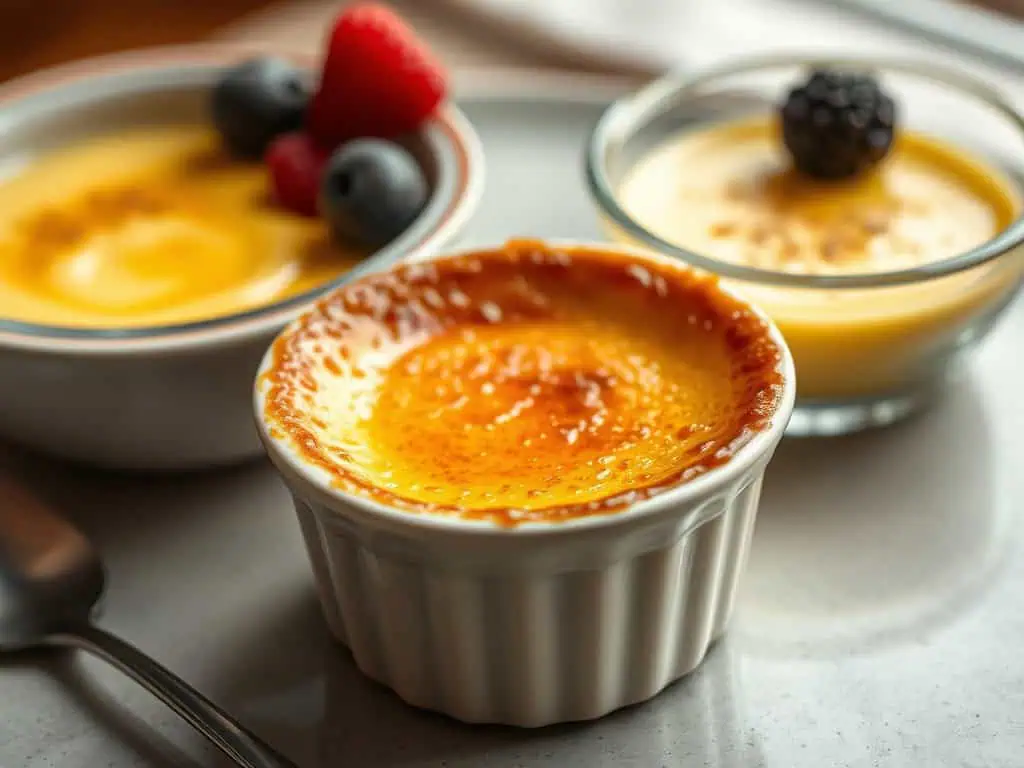
Crème brûlée and custard are both creamy and delicious desserts, but they have distinct characteristics that set them apart. While both are rich in flavor, they differ in texture, preparation, and presentation. In this article, we’ll explore the key differences between crème brûlée and custard, as well as how to make each one.
What is Crème Brûlée?
Crème brûlée, often regarded as a luxurious dessert, is a French dish made with egg yolks, heavy cream, vanilla, and sugar. The key feature that sets crème brûlée apart is its crunchy caramelized sugar topping, which contrasts perfectly with the smooth custard beneath. The name “crème brûlée” literally means “burnt cream,” referring to the process of caramelizing the sugar using a torch or broiler.
How Crème Brûlée Differs from Regular Custard
Both crème brûlée and custard contain eggs and cream, but they differ mainly in how you prepare them:
- Crème brûlée bakes in a water bath at a low temperature to create a delicate custard. After baking, you sprinkle sugar on top and caramelize it, creating a crunchy topping.
- Custard, however, is a more general term. It refers to any creamy mixture of milk or cream and eggs that thickens when cooked. It doesn’t have the caramelized sugar topping typical of crème brûlée, making it a simpler dessert.
For more on how to make basic custard, check out this recipe for custard from scratch.
Understanding Custard
Custard is a versatile dish. You can make it in many different forms, from thick fillings for pastries to lighter sauces served alongside desserts. The basic ingredients include egg yolks, milk or cream, and sugar. You can cook custard on the stovetop or in the oven, depending on the recipe. One popular variation is crème anglaise, a poured custard that pairs well with other desserts.
Types of Custard
You can divide custard into several types, based on texture and use:
- Pastry cream: A thick custard used as a filling in cakes and pastries.
- Baked custard: This custard sets in the oven and is often served in ramekins. It’s similar to crème brûlée but lacks the caramelized topping.
- Stirred custard: Cooked on the stovetop and stirred constantly to prevent curdling.
If you enjoy baking custard-based desserts, try this Pumpkin Banana Loaf which uses a custard-like filling.
The Key Differences Between Crème Brûlée and Custard
The main differences between crème brûlée and custard are in texture, preparation, and presentation:
- Texture: Crème brûlée has a smooth, velvety texture with a crunchy top, while custard is creamy and soft throughout.
- Preparation: Crème brûlée requires a water bath for baking, while you can cook custard either on the stove or in the oven.
- Serving: You typically serve crème brûlée in ramekins, with the sugar topping caramelized. Custard can be served in various forms, such as a sauce or as a filling for cakes.
For more on perfecting custard techniques, check out this guide on making perfect custard every time.
How to Make the Perfect Crème Brûlée
To make crème brûlée, you’ll need the following ingredients:
- Heavy cream
- Egg yolks
- Sugar
- Vanilla extract
- A torch for caramelizing the sugar topping
Steps for Making Crème Brûlée:
- Preheat your oven to 325°F (163°C) and place your ramekins in a shallow pan.
- In a saucepan, heat the heavy cream and vanilla extract until it’s hot but not boiling.
- Whisk together the egg yolks and sugar until fully combined.
- Slowly pour the hot cream mixture into the egg yolk mixture, stirring constantly.
- Pour the custard into the ramekins and bake in a water bath for 30–40 minutes.
- Once the custards have set, allow them to cool. Just before serving, sprinkle sugar on top and caramelize it using a kitchen torch.
For a more detailed breakdown of baking custards, read this article on The Secret to Making Cookies Soft and Chewy.
Conclusion
Crème brûlée and custard are both delicious and creamy, but they differ in preparation and presentation. Whether you’re making the rich, silky texture of a crème brûlée or experimenting with custard in various forms, both are sure to impress your guests. Understanding these differences will help you appreciate each dish’s unique qualities, and maybe inspire you to try making both in your own kitchen!
